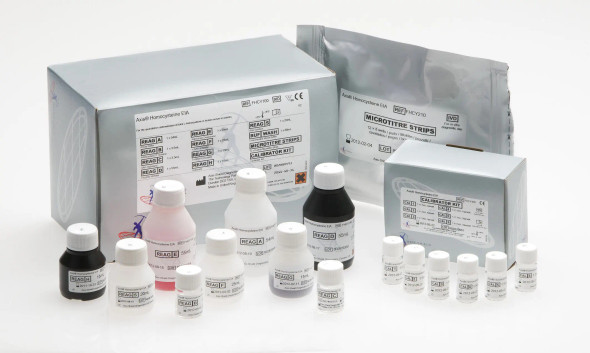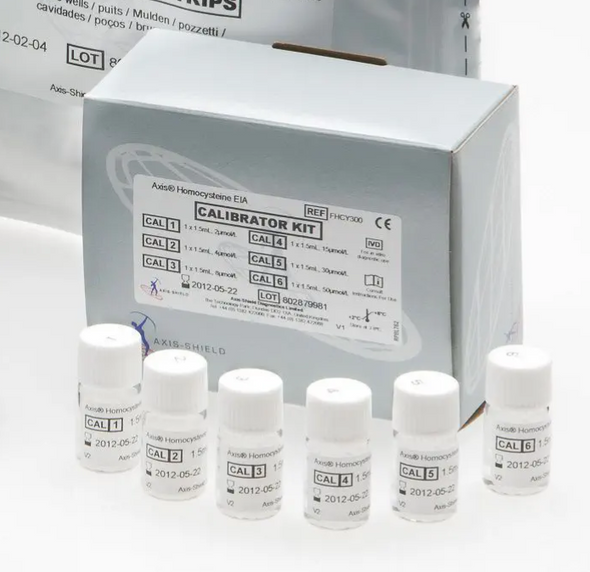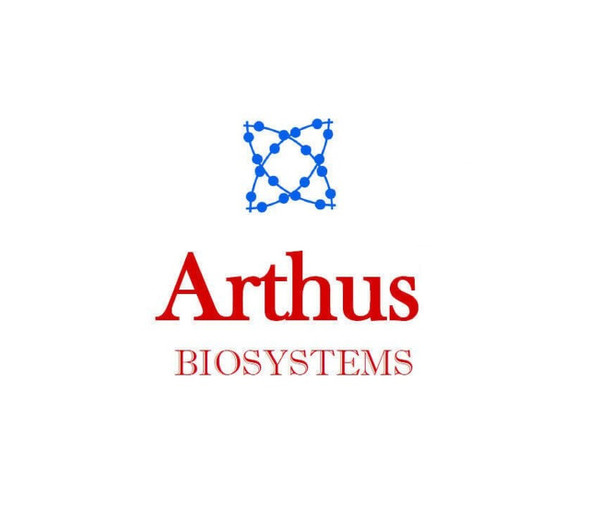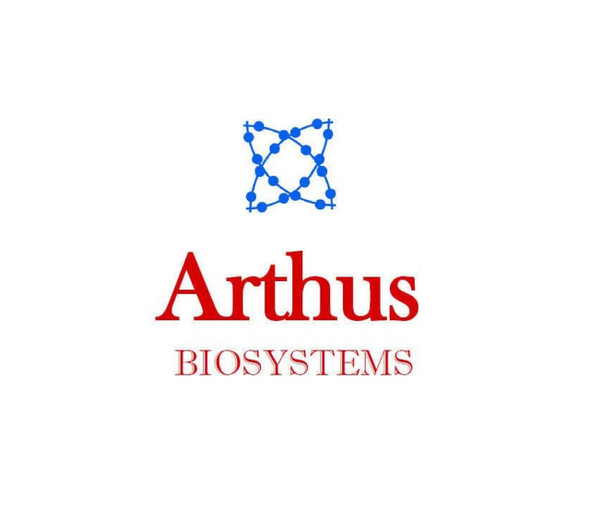Description
Over the past few years, routine laboratory Homocysteine (HCY) testing has begun to move away from the mainframe immunoassay analysers onto clinical chemistry platforms.
Axis-Shield has been at the forefront of this change with the Liquid Stable 2-Part Homocysteine Reagent.
The Axis-Shield Liquid Stable 2-Part Homocysteine Reagent offers performance equivalent to immunoassay and also allows:
- Instrument consolidation
- Lower turn-around time
- Improved reagent stability
- Ease of use
The Axis-Shield Liquid Stable 2-Part Homocysteine Assay is a next-generation 2-Reagent assay offering superior performance and stability.
Axis-Shield Liquid Stable 2-Part Homocysteine Reagent Brochure
Axis-Shield Liquid Stable 2-Part Homocysteine Reagent DataSheet
The key features and performance characteristics of the assay are described below:
Intended Use
The Liquid Stable (LS) 2-Part Enzymatic Homocysteine assay is intended for in vitro quantitative determination of total homocysteine in human serum and plasma.
Assay Principle
In the Axis-Shield Liquid Stable 2-Part Homocysteine assay, bound or dimerised homocysteine (oxidised form) is reduced to free homocysteine, which then reacts with serine catalysed by cystathionine beta-synthase (CBS) to form L-cystathionine. Cystathionine in turn is broken down by cystathionine beta-lyase (CBL) to form homocysteine, pyruvate and ammonia. Pyruvate is then converted by lactate dehydrogenase (LDH) to lactate with NADH as coenzyme. The rate of NADH conversion to NAD is directly proportional to the concentration of homocysteine.
Key Features
- Method: Enzymatic assay
- Sample type: Serum or Serum Separator Tubes and EDTA or heparinized plasma
- Sample volume: from 16µL
- Lower limit of detection: 0.4 µmol/L
- Assay Range: 1-46 µmol/L
- Calibrators: 0 & 28 µmol/L (included in kit)
- Tests used for calibration: 4 per month (older 3-reagent systems can use up to 50 tests per month for calibrations)
- Calibration Curve Stability: up to 30 days
- On-board Reagent Stability: up to 30 days
- Standardised: To NIST SRM 1955 (Homocysteine Standard Reference Material)
- Time to first result: 12 minutes (calibrated Instrument)
- Throughput: 36 test per hour (calibrated Instrument)
- Reagents: Ready to use with calibrators included
- Pack sizes to suit your usage: available in 100, 200 & 1000 test formats.
Linearity of diluted plasma samples:
If the Homocysteine concentration of a sample exceeds the range of the calibration curve, the sample should be diluted one part specimen with two parts Cal 0µmol/L (provided in the kit) and be reanalysed.
The Axis-Shield Homocysteine Control kit (tri-level, 1.5mL each) is also available for use with this product- FHCY200
INTENDED USE
The Liquid Stable (LS) 2-Part Homocysteine Reagent is intended for in vitro quantitative determination of total homocysteine in human serum and plasma. The device can assist in the diagnosis and treatment of patients suspected of having hyperhomocysteinemia and homocystinuria.
PRINCIPLE OF THE ASSAY
This assay consists of two key steps:
- Reduction: Dimerised homocysteine, mixed disulfide, and protein-bound forms of Homocysteine (HCY) in the sample are reduced to form free HCY by the use of tris [2-carboxyethyl] phosphine (TCEP).
- Enzymatic Conversion: Free HCY is converted to cystathionine by the use of cystathionine beta-synthase (CBS) and excess serine. The cystathionine is then broken down to homocysteine, pyruvate and ammonia via cystathionine beta-lyase (CBL). Pyruvate is converted to lactate via lactate dehydrogenase (LDH) with nicotinamide adenine dinucleotide (NADH) as coenzyme. The rate of NADH conversion to NAD+ (measured at A340 nm) is directly proportional to the concentration of homocysteine.
STANDARDISATION
The calibrators are traceable to NIST SRM 1955, confirmed by a designated measurement procedure (HPLC).
ITEMS REQUIRED BUT NOT PROVIDED
An analyzer capable of dispensing 2 reagents and measuring absorbance at 340 nm with temperature control (37˚C). An Axis-Shield Homocysteine Control Kit (FHCY200) is sold separately and is available for use with the Liquid Stable (LS) 2-Part Homocysteine Reagent.
STORAGE OF REAGENTS, HANDLING AND PROCEDURAL NOTES
- Store kit components at 2-8˚C and use until the expiry date on the labels. Do not use expired reagents. DO NOT FREEZE REAGENTS.
- Reagents may be used on multiple occasions until the expiry date on the labels. Reagents must be returned to 2-8°C storage between use.
- Do not mix different reagent kit lot numbers.
- Do not expose Reagent 1 and Reagent 2 to light during on-board use.
- Avoid contamination of reagents. Use a new disposable pipette tip for each reagent or sample manipulation.
- Reagents should be clear of particulate material and should be discarded if they become turbid.
WARNINGS AND SAFETY PRECAUTIONS
- Reagent 1 and Reagent 2 contain sodium azide which can react with lead or copper plumbing to form highly explosive metal azides. On disposal, flush with large quantities of water to prevent azide build-up.
- Material safety data sheets are available upon request from Axis-Shield.
ASSAY PROCEDURE
- Programme instrument using appropriate instrument protocols.
- Load reagents and samples onto the instrument as instructed.
- Run assay.
SPECIMEN COLLECTION AND HANDLING
1. Serum (collected in serum or serum separator tubes) and plasma (collected in potassium EDTA or lithium heparin tubes) may be used for the measurement of homocysteine. However, it is not recommended to use individual patient results from serum, heparinized plasma and EDTA plasma interchangeably.11 Additionally matrix differences between serum and serum separator tubes and plasma tubes have been reported.1 To minimize increases in homocysteine concentration from synthesis by red blood cells, process specimens as follows:
-
- Place all specimens (serum and plasma) on ice after collection and prior to processing. Serum may clot more slowly and the volume may be reduced.2
- All specimens may be kept on ice for up to 6 hours prior to separation by centrifugation.1
- Separate red blood cells from serum or plasma by centrifugation and transfer to a sample cup or other clean container.
Note: Specimens not placed on ice immediately may exhibit a 10- 20% increase in homocysteine concentration.3
2. If the assay will be performed within 2 weeks after collection, the specimen should be stored at 2-8˚C. If the testing will be delayed more than 2 weeks, the specimen should be stored frozen at -20˚C or colder. Specimens have been shown to be stable at -20˚C for 8 months. Mix specimens thoroughly after thawing. Avoid multiple freeze-thawing. 1,2
3. Specimens containing particulate matter (fibrin, red blood cells, or other matter) and visibly lipaemic specimens should not be used with the assay. Results from these specimens may be inaccurate.
QUALITY CONTROL PROCEDURES
Maintenance and calibration of the instrument must be performed according to the manufacturer’s instructions. Assayed control materials with values for homocysteine in both the normal and abnormal ranges should be tested to validate reagent performance. Users should demonstrate that they obtain performance specifications for precision and reportable range of test results comparable to those established by the manufacturer before reporting patient test results.
EXPECTED VALUES
The reference range should be determined by each laboratory. HCY concentrations in healthy individuals varies with age, gender, geographical areas and genetic factors. Scientific literature reports reference values for adult male and females between 5-15 µmol/L2,4,5. A reference range among an elderly population (> 60 years) is 5-20 µmol/L.6 In countries with folic acid fortification programmes, reduced levels of HCY may be observed.7,8 As a point of reference the ranges quoted above may be used until the laboratory has analysed a sufficient number of specimens to determine its own reference range.
LIMITATIONS OF USE
- In Vitro Diagnostic Use. For professional use only.
- The linear range of the Liquid Stable (LS) 2-Part Homocysteine Reagent when run as directed is 1-46 µmol/L for the BECKMAN COULTER AU400 and COBAS Integra 800; 2-46 µmol/L for the ROCHE Hitachi 917 and ROCHE Modular P and 2-44 µmol/L for the BECKMAN COULTER AU480, AU680 and AU5800.
- Specimens >46 µmol/L should be diluted 1 part specimen to 2 parts Cal 0 µmol/L or 1 part specimen to 9 parts Cal 0 µmol/L as appropriate.
- Cystathionine is measured with homocysteine, but in the general population the cystathionine level (0.065 to 0.3 µmol/L) has a negligible effect. In very rare cases, end stage renal disease and patients with severe metabolic disturbances, cystathionine levels may rise dramatically and in severe cases cause greater than 20% interference.9,10
- Hydroxylamine, present in several iron reagents may carryover (reagent probe or reaction cuvette) and cause falsely low results. Routine rinsing procedures are not adequate to eliminate this problem in most cases. Possible solutions would include special washing protocols, changing to an iron assay that used ascorbic acid as reductant or running iron and homocysteine assays on separate instruments.
- Carbamazepine, methotrexate, phenytoin, nitrous oxide, or 6-azauridine triacetate may affect the homocysteine concentration.1
- Note: Specimens from patients who are on drug therapy involving Sadenosyl-methionine may show falsely elevated levels of homocysteine. Patients who are taking methotrexate, carbamazepine, phenytoin, nitrous oxide, anticonvulsants, or 6-azauridine triacetate, may have elevated levels of homocysteine due to their effect on the pathway.
- Specimens containing particulate matter (fibrin, red blood cells, or other matter) and visibly lipaemic specimens should not be used with the assay. Results from these specimens may be in accurate.
RESULTS
The results are calculated automatically and are presented in µmol/L. Ensure results are multiplied by the correct dilution factor.
PERFORMANCE DATA
Data presented were generated on the BECKMAN COULTER AU systems (AU400, AU480, AU680, AU5800), COBAS INTEGRA 800, ROCHE Hitachi 917 and ROCHE Modular P systems. Results may vary depending on the system used. Other instrument protocols are available. It is the responsibility of the user to verify performance.
2 Reviews
-
FHRWR100
Goood serivice, reasonable price
-
Wonderfull
I have a query about some products, but the staff helped me a lot in a very well way. A wonderful experience it was for me






